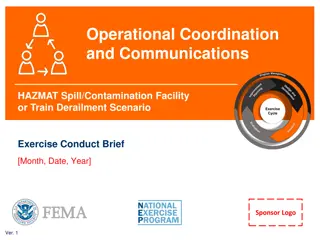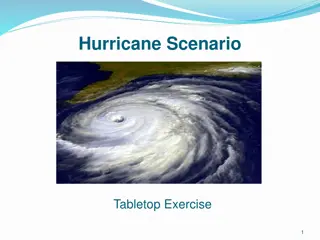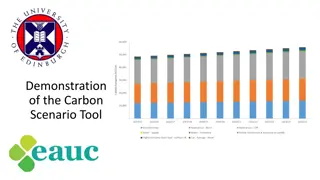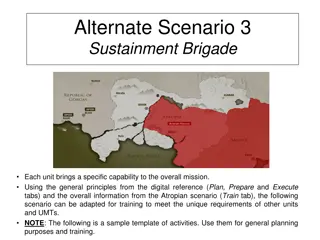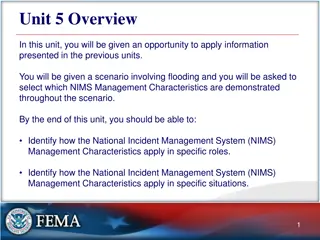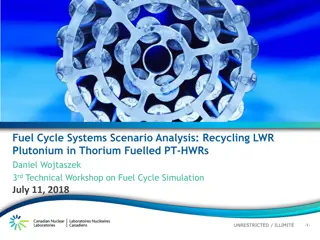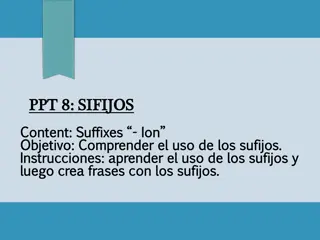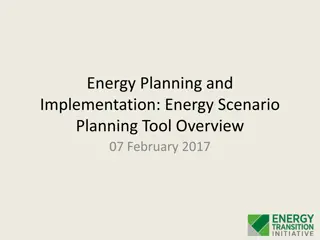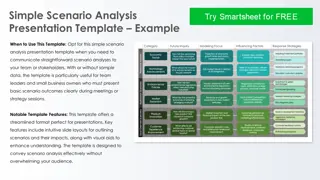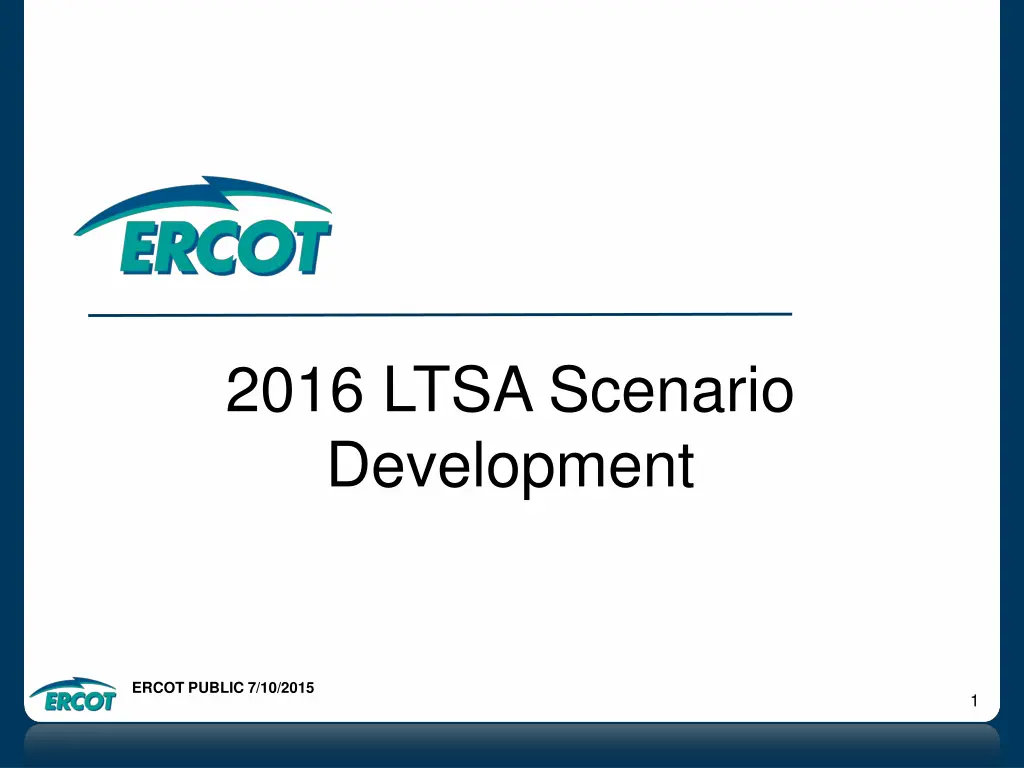
ERCOT Public Scenario Development 2016
"Explore the scenario development process for the ERCOT grid in 2016, covering trends, forecasts, drivers, and key factors impacting generation expansion and load forecasts. Dive into scenarios focusing on technology, economic growth, government mandates, environmental regulations, end-use trends, alternative generation, weather, water, and natural gas prices."
Download Presentation

Please find below an Image/Link to download the presentation.
The content on the website is provided AS IS for your information and personal use only. It may not be sold, licensed, or shared on other websites without obtaining consent from the author. If you encounter any issues during the download, it is possible that the publisher has removed the file from their server.
You are allowed to download the files provided on this website for personal or commercial use, subject to the condition that they are used lawfully. All files are the property of their respective owners.
The content on the website is provided AS IS for your information and personal use only. It may not be sold, licensed, or shared on other websites without obtaining consent from the author.
E N D
Presentation Transcript
2016 LTSA Scenario Development ERCOT PUBLIC 7/10/2015 1
Outline Scenario development process Objectives Scenario template Next steps ERCOT PUBLIC 7/10/2015 2
Scenario development process 2014 LTSA review Review of trends and forecasts Scenario development Review drivers, scenarios and results from 2014 LTSA Identify scenarios that can be developed further Identify drivers on which more information would be helpful Expert presentations Review of updated information regarding trends and forecasts Develop scenarios to be tested in the 2016 LTSA Develop input assumptions that will be used to model each scenario ERCOT PUBLIC 7/10/2015 3
Objectives of this session Identify at a minimum three, but no more than ten scenarios for which generation expansion plan and load forecasts will be developed Each scenario description should be granular and detailed in order to facilitate generation expansion and load forecast development Use the scenario development template as a guideline to build each scenario ERCOT PUBLIC 7/10/2015 4
Scenario: Name Technology: Improvement in technology such as combined cycle capability, wind turbines, solar PV panel efficiency, renewable-storage combination, battery technology, etc. Economic Growth: What does the economic growth/decline in Texas look like? What premises are growing? residential/commercial/industrial What is the % population growth/reduction rate? What is the geographic distribution of this change? Oil and gas development? Story: Summarize the scenario based on the assumptions around the driver. This section shall paint the picture of the future state of Texas/US which will impact ERCOT grid based on these key drivers. Government Mandates/Policy: Any government mandates reserve margin requirement, discussions on DC ties, transmission mandates, etc. Environmental Regulation: Discuss the environmental regulations in place for this given future? These regulations may include those on oil and gas development-nuclear licensing-plant retirements, water usage for generation End-Use: Trends in demand side management - EE, DG, Roof-top PV, storage, Demand response. Growth in Electric Vehicles Alternative Generation: Discuss capital cost considerations for renewable and storage Any incentives/tax credits towards alternative generation? Implications for ERCOT: Take away for the planning assessment: Load and generation assumptions to be used to build load forecast and generation expansion models. Also, include special considerations during transmission planning. Weather / Water Weather assumptions extreme heat, moderate summers? Impact of hydrological cycles drought Impact of water stressed conditions Natural Gas Prices: Global as well as local natural gas price forecast. ERCOT PUBLIC 7/10/2015 5
Drivers used in 2014 LTSA Drivers Brief Description US and Texas economy, regional and state-wide population, oil & gas, and industrial growth, LNG export terminals, urban/suburban shifts, financial market conditions and business environment Economic Conditions Environmental regulations including air emissions standards (e.g., ozone, MATS, CSAPR), GHG regulations, water regulations (e.g., 316b), and nuclear safety standards; energy policies include renewable standards and incentives (incl. taxes/financing), mandated fuel mix, solar mandate, and nuclear re-licensing. Environmental Regulations and Energy Policies Capital cost trends for renewables (solar and wind), technological improvements affecting wind capacity factors, caps on annual capacity additions, storage costs, other DG costs, and financing methods. Alternative Generation Resources Gas prices are a function of total gas production, well productivity, LNG exports, industrial gas demand growth, and sometimes oil prices. Natural Gas Prices ERCOT PUBLIC 7/10/2015 6
Drivers used in 2014 LTSA Drivers Brief Description New policies around resource adequacy, transmission build-out, interconnections to neighboring regions and cost recovery Government Regulations/Pol icy/Mandates Improvements in technologies resulting in more efficient turbines, or higher capacity factor intermittent resources Technology End use technologies, efficiency standards and incentives, demand- response, changes in consumer choices, DG growth, increase interest in microgrids End-Use/New Markets May affect load growth, environmental regulations and policies, technology mix, average summer temperatures, frequency of extreme weather events, water costs Weather and Water Conditions ERCOT PUBLIC 7/10/2015 7
Scenario shortlisting Using 2014 LTSA scenario list as starting point identify any scenarios that can be: Added Rejected Retained but modified Merged with other scenarios ERCOT PUBLIC 7/10/2015 8
Questions? ERCOT PUBLIC 7/10/2015 9
1. Scenario: Current Trends Transmission Regulation /Policy Policy set to reduce constraints Increased DC-tie capacity with neighboring region Higher reliability standards are set by NERC to avoid load shedding Economic Growth Migration to TX along I-35 corridor Growth in south Texas Industrial growth in Houston, I-35, Midland/Odessa, Valley ~1.5% load growth high growth in near term then tapering off in long-term LNG growth based on permits existing needs review Oil production rates follow trend in recent EIA projections for Texas Story: Same old, same old. The recent population and economic growth in Texas continues in the near future, fueled largely by the continued growth of the oil and gas sector and the relative robust Texas economy compared to the rest of the U.S. World oil prices high enough to keep increasing oil production in the short-term, keeping domestic natural gas prices relatively low. With low gas prices, several LNG export terminals are built between 2014 and 2024. Modest wind growth continues based on economics without production tax credits. Capital costs for solar continues to decline at a slower rate than recent history. No required reserve margin is set for ERCOT and the environmental regulations continues to be moderate, with no explicit federal carbon tax or required national cap and trade, but greenhouse gas emissions become regulated beyond 2016. Generation Resource Adequacy No reserve margin set for ERCOT Maintain energy-only market Economic retirements continues based on economics Environmental Regulation MATS and 316B are implemented by 2016 CSAPR Hybrid Greenhouse gas regulation set with flexibility No other major changes in environmental regulations End-Use Increased need for ancillary services Increase penetration of demand response Increasing distributed generation Alternative Generation Solar: 1000 MW / year Wind capacity addition limit: 3,000 MW/yr Capacity factor wind rely on historical data from ERCOT Capital cost wind ~$2,000/kW Capital cost solar ~4.4% reduction/year Overall renewable growth driven by economic entry No production tax credit beyond 2013 No change to existing investment tax credit policy Implications for ERCOT: Continued modest economic and therefore load growth in Texas. Growth in oil production and population across the state leads to new transmission needs Continued increased renewables leading to reliability (inertia) issues No major generation retirements triggered by stringent environmental regulations. Weather / Water No drought situation, but water supply continues to be a concern to existing and new generators. No specific increase in electricity consumption due to drought conditions. Gas/Oil Prices EIA reference case or best available gas and oil price forecasts ERCOT PUBLIC 7/10/2015 10



